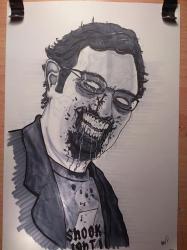So then, time for the big guns.
I think it’s fair to say that, even if you’ve never seen it, everyone will be familiar with the imagery of Stanley Kubrick’s head-f*@# of a science fiction movie. Not least because of The Simpsons. So, let’s cut straight to the nitty gritty.
2001 had its genesis in a letter that the renowned director sent to science fiction luminary Arthur C. Clarke in the 1960s, asking for help in penning “the proverbial good science fiction movie”. It was a genre that Kubrick had never worked in before, being known at the time primarily for historical epic Spartacus. Having just completed Dr Strangelove, Kubrick was keen to get on with another project even though he considered Clarke to be “a recluse, a nut who lives in a tree” since Clarke lived in what is now Sri Lanka. The ‘nut’, however, was keen to work with the enfant terrible of 60s cinema and the two began fleshing out their basic ideas into a project that would rule their lives for four years.
The pair quickly settled on using Clarke’s short story The Sentinel as the basis for the plot, Kubrick having rejected ideas like machines that saw organic life as a disease as “cute”. Two years were spent turning The Sentinel into a novel, then the novel manuscript into a screenplay. In the process, elements of another Clarke short story called Encounter at Dawn were incorporated, inspiring the movie’s opening scenes. After eleven months of writing, by which time they had even approached astronomer Carl Sagan for advice on how to best portray extraterrestrial life, Clarke and Kubrick had a screenplay and the director started preproduction.
If the storyline can be distilled down, the film encompasses the beginnings of human evolution as a mysterious alien monolith influences a troop of apes to begin using tools for the first time. Fast-forward to the early 21st Century and NASA scientists have discovered a similar monolith buried on the Moon inside the crater Tycho. Once dug up, the monolith sends out a radio signal as soon as sunlight touches it. Spin on another year or so and we find the NASA spacecraft Discovery One ferrying the first manned mission to Jupiter. Three astronauts are in cryonic freeze to avoid using up food and water, while Frank Poole and Dave Bowman kill time and monitor artificially intelligent computer HAL 9000. HAL begins acting erratically, cutting off communication with mission control and ramming Poole with a space pod when he goes out to repair the antenna. When Bowman goes out to try and recover his colleague, HAL shuts down the freezers of the other three crew and strands Bowman outside the ship without a space suit. Bowman manages to eject himself from his pod and into Discovery’s air lock without dying, before shutting HAL down and seeing a video explaining the top secret discovery of alien life and the radio signal sent to Jupiter. Eventually getting to the giant planet and discovering a giant monolith in orbit of it, Bowman investigates only for his space pod to be sucked into it and through a trippy stargate sequence to a luxury hotel. Here he is artificially aged by yet another monolith and then reborn as a glowy foetus in Earth orbit. The End.
As is inevitable with any Kubrick production, the film was completed 11 months late and $4 million over its original $6.5 million budget. This was an amazing figure for the 1960s and reflects the excruciating detail that visual effects director Douglas Trumbull went to in order to portray a truly realistic picture of travelling through space. Despite the epic cost overrun, significant elements of the screenplay were dropped on cost grounds. Originally, the film’s climactic sequence would have taken place in orbit of Saturn’s moon Iapetus, with the monolith/stargate located on the surface. Jupiter would have appeared earlier in the film as Discovery carried out a slingshot around it to boost its speed. Saturn was dropped and the monolith moved into orbit of Jupiter instead.
So, how’s it stack up? Sadly, not as well as Kubrick’s other movies. Apart from the fact that it’s now 2015 and humanity hasn’t even left Earth orbit since 1972, let alone built nuclear-powered spaceships with artificial gravity, artificially intelligent computers and suspended animation capsules, it’s simply not a hugely entertaining film. At almost three hours of complete and utter confusion, with missing explanations of what the bloody hell is happening at every turn, it isn’t so much a film as an endurance exercise. It’s packed with great visuals and truly impressive effects for 1968, and is one of the few films to give a true depiction of the eerie silence of travelling through a vacuum. However, the bottom line is that it is largely incomprehensible.
The book’s better. The book actually makes sense.
3/5 nerds.




Nerd Comments